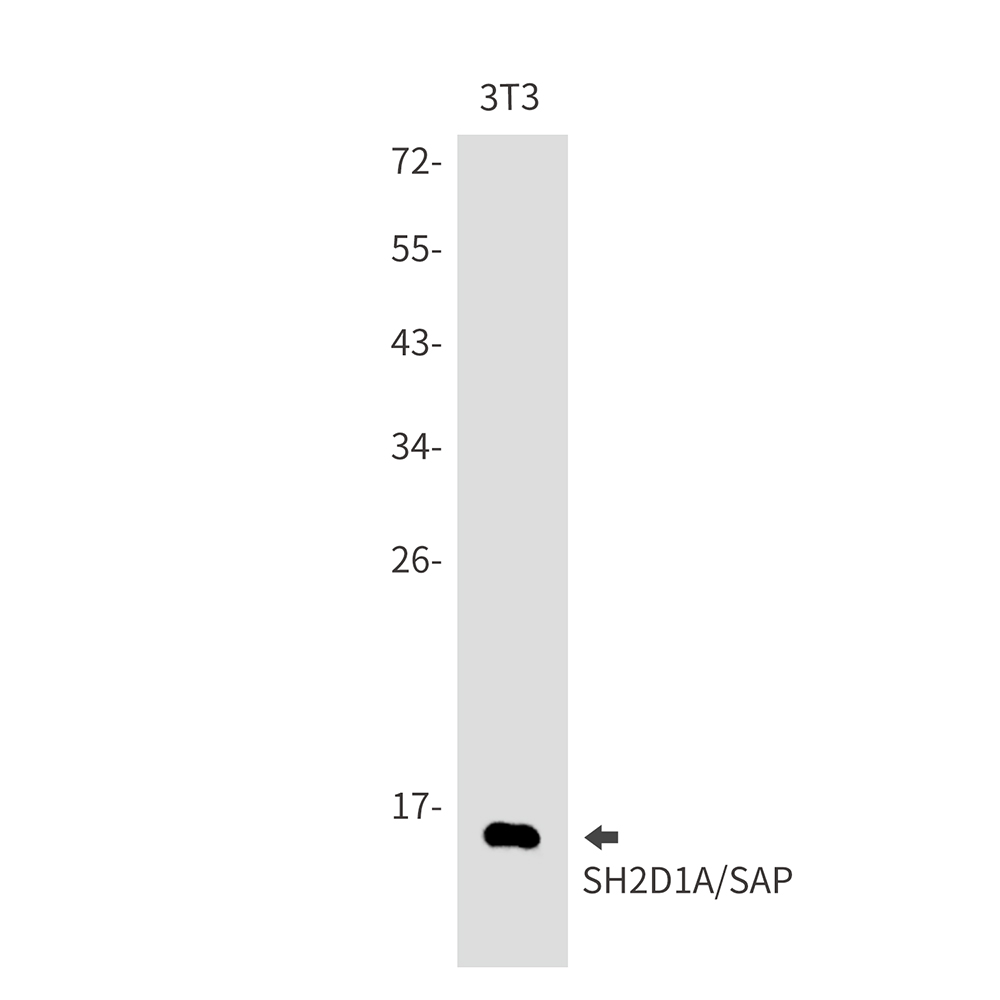SH2D1A Rabbit mAb
- SPECIFICATION
- CITATIONS
- PROTOCOLS
- BACKGROUND

Application
| WB |
|---|---|
| Primary Accession | O60880 |
| Reactivity | Human, Mouse, Rat |
| Host | Rabbit |
| Clonality | Monoclonal Antibody |
| Calculated MW | 14187 Da |
| Gene ID | 4068 |
|---|---|
| Other Names | SH2D1A |
| Dilution | WB~~1/500-1/1000 |
| Format | 50mM Tris-Glycine(pH 7.4), 0.15M NaCl, 40%Glycerol, 0.01% sodium azide and 0.05% BSA. |
| Storage | Store at 4°C short term. Aliquot and store at -20°C long term. Avoid freeze/thaw cycles. |
| Name | SH2D1A |
|---|---|
| Synonyms | DSHP, SAP |
| Function | Cytoplasmic adapter regulating receptors of the signaling lymphocytic activation molecule (SLAM) family such as SLAMF1, CD244, LY9, CD84, SLAMF6 and SLAMF7. In SLAM signaling seems to cooperate with SH2D1B/EAT-2. Initially it has been proposed that association with SLAMF1 prevents SLAMF1 binding to inhibitory effectors including INPP5D/SHIP1 and PTPN11/SHP-2 (PubMed:11806999). However, by simultaneous interactions, recruits FYN which subsequently phosphorylates and activates SLAMF1 (PubMed:12458214). Positively regulates CD244/2B4- and CD84-mediated natural killer (NK) cell functions. Can also promote CD48-, SLAMF6 -, LY9-, and SLAMF7-mediated NK cell activation. In the context of NK cell-mediated cytotoxicity enhances conjugate formation with target cells (By similarity). May also regulate the activity of the neurotrophin receptors NTRK1, NTRK2 and NTRK3. |
| Cellular Location | Cytoplasm. |
| Tissue Location | Expressed at a high level in thymus and lung, with a lower level of expression in spleen and liver. Expressed in peripheral blood leukocytes, including T-lymphocytes. Tends to be expressed at lower levels in peripheral blood leukocytes in patients with rheumatoid arthritis. |

Thousands of laboratories across the world have published research that depended on the performance of antibodies from Abcepta to advance their research. Check out links to articles that cite our products in major peer-reviewed journals, organized by research category.
info@abcepta.com, and receive a free "I Love Antibodies" mug.
Provided below are standard protocols that you may find useful for product applications.
If you have used an Abcepta product and would like to share how it has performed, please click on the "Submit Review" button and provide the requested information. Our staff will examine and post your review and contact you if needed.
If you have any additional inquiries please email technical services at tech@abcepta.com.













 Foundational characteristics of cancer include proliferation, angiogenesis, migration, evasion of apoptosis, and cellular immortality. Find key markers for these cellular processes and antibodies to detect them.
Foundational characteristics of cancer include proliferation, angiogenesis, migration, evasion of apoptosis, and cellular immortality. Find key markers for these cellular processes and antibodies to detect them. The SUMOplot™ Analysis Program predicts and scores sumoylation sites in your protein. SUMOylation is a post-translational modification involved in various cellular processes, such as nuclear-cytosolic transport, transcriptional regulation, apoptosis, protein stability, response to stress, and progression through the cell cycle.
The SUMOplot™ Analysis Program predicts and scores sumoylation sites in your protein. SUMOylation is a post-translational modification involved in various cellular processes, such as nuclear-cytosolic transport, transcriptional regulation, apoptosis, protein stability, response to stress, and progression through the cell cycle. The Autophagy Receptor Motif Plotter predicts and scores autophagy receptor binding sites in your protein. Identifying proteins connected to this pathway is critical to understanding the role of autophagy in physiological as well as pathological processes such as development, differentiation, neurodegenerative diseases, stress, infection, and cancer.
The Autophagy Receptor Motif Plotter predicts and scores autophagy receptor binding sites in your protein. Identifying proteins connected to this pathway is critical to understanding the role of autophagy in physiological as well as pathological processes such as development, differentiation, neurodegenerative diseases, stress, infection, and cancer.



